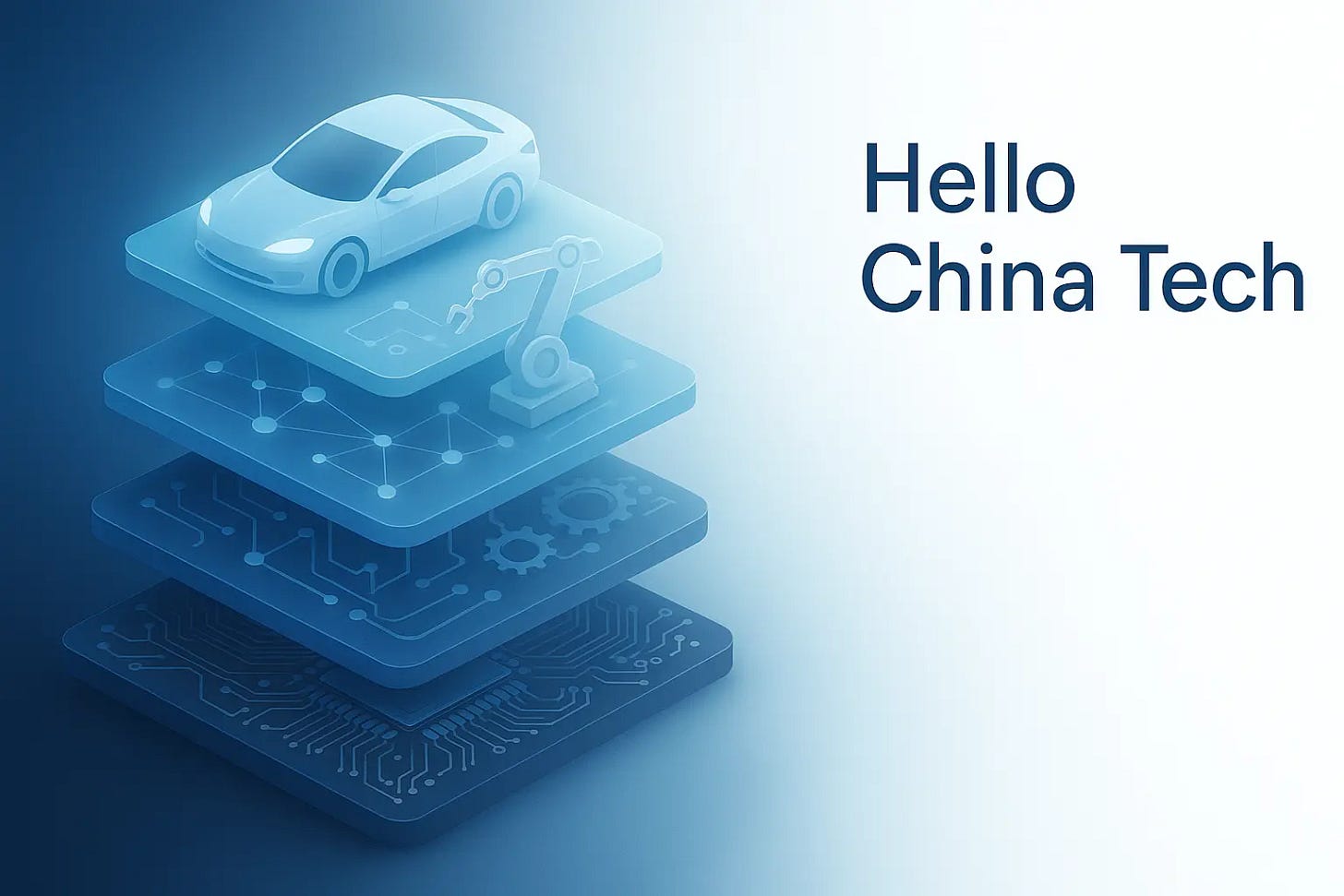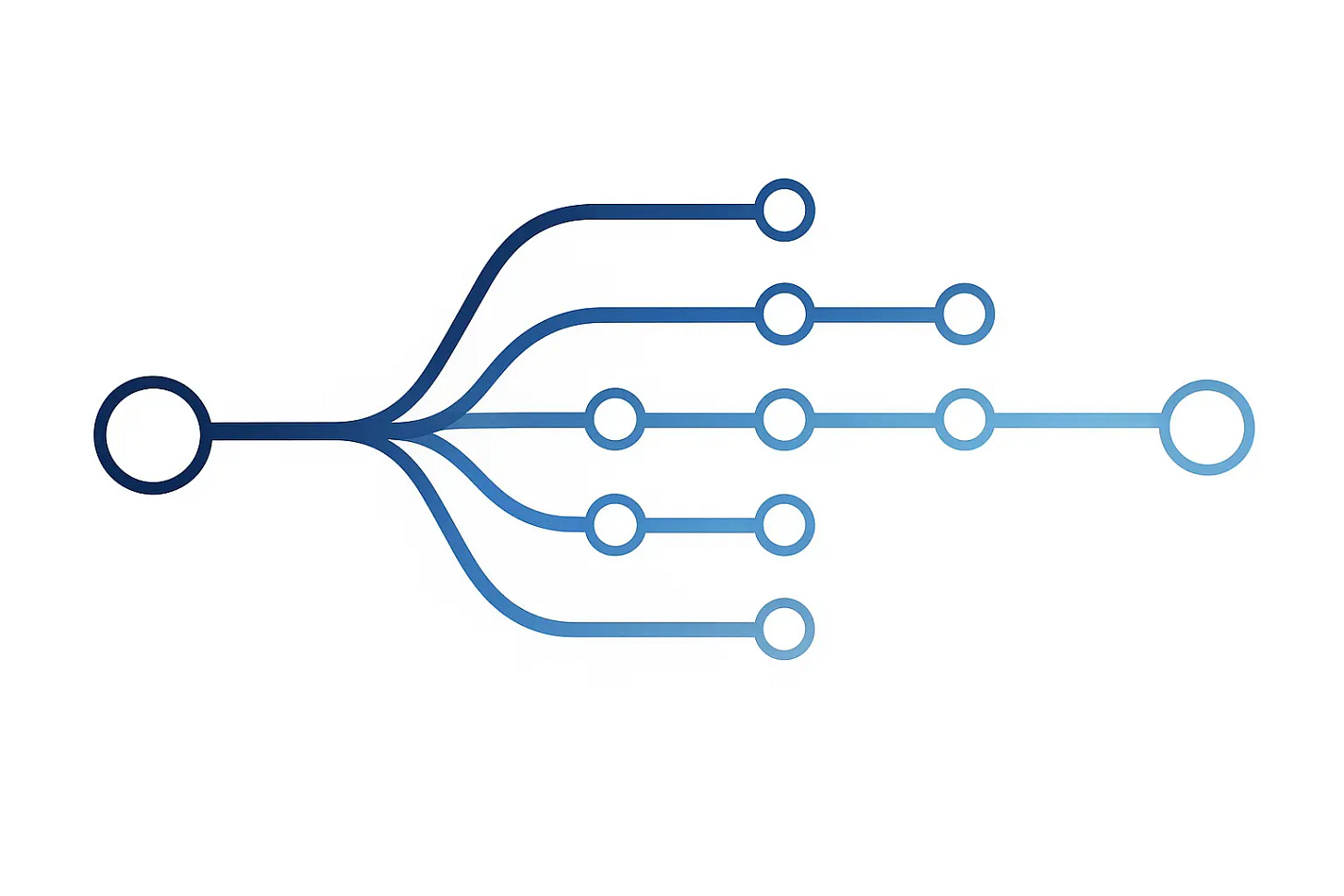The Hello China Tech Reading Guide: Where to Start When Everything Connects
A strategic roadmap for investors, entrepreneurs, and strategists who want to understand what's really happening beyond the headlines.
Why This Newsletter Exists (And Why You Need It)
While Western media focuses on “tech war” headlines and trade tensions, the real story of China’s technology evolution is far more nuanced—and strategically important. China’s tech ecosystem has moved beyond copying Silicon Valley playbooks into something entirely different: a pragmatic, application-first approach that’s often more commercially viable than Western moonshot strategies.
This isn’t about being “pro-China” or “anti-US.” It’s about understanding a parallel technology development model that could reshape how innovation reaches market globally. Whether you’re an investor evaluating opportunities, a strategist planning for geopolitical shifts, or an entrepreneur studying different approaches to technology commercialization, you need to understand this evolution.
I’m Poe Zhao, and through Hello China Tech, I bridge the gap between China’s rapidly evolving tech ecosystem and the global community. My unique position—observing China’s tech ecosystem daily while writing for global investors and entrepreneurs—gives me insights into strategic patterns that pure China watchers and pure Silicon Valley observers often miss.
The Framework: Four Interconnected Themes
I’ve organized China’s tech revolution into four interconnected themes that together reveal a coherent strategic approach. Think of these as layers in a stack, where each influences and depends on the others:
🔹 Foundation Layer: AI Chips & Semiconductors- The geopolitical and technical foundation
🔹 Intelligence Layer: Large Models & AI Applications - How software builds on constrained hardware
🔹 Physical Layer: Robotics & Manufacturing - Where AI meets the real world
🔹 Market Reality: Electric Vehicles & Energy - The brutal testing ground for all strategies
Your Reading Roadmap
Start Here: Understanding the Big Picture
📖 “The Digital Vine: How China’s Tech Giants Are Growing on a Western Trunk”
This piece reframes the entire China-US tech relationship. Forget the “decoupling” narrative—Chinese companies are becoming the biggest customers of their American rivals while building global infrastructure that runs on Western cloud platforms. It’s the perfect introduction to how complex and intertwined this ecosystem really is.
Why start here: It breaks the false binary of “cooperation vs competition” and shows you the real dynamics driving both countries’ tech strategies.
Theme 1: Foundation Layer - The Semiconductor Reality
🔹 “The Geopolitical Arbitrage Playbook”
Start with this foundational piece that introduces the core concept driving China’s chip industry. US sanctions didn’t just create barriers—they created a protected domestic market that functions as both opportunity and trap.
🔹 “Stress Test in China’s AI-Chipland”
When NVIDIA’s H20 chips returned to market, it revealed the harsh reality behind “geopolitical arbitrage.” This piece shows you why the business model is more fragile than it appears and how market forces are reshaping the industry.
The strategic alternative: How T-Head is pursuing “architecture sovereignty” through open-source RISC-V—a completely different approach to the chip challenge that could reshape the entire computing stack.
Key insight: China’s chip strategy isn’t just about catching up—it’s about creating alternative architectures that bypass current constraints entirely.
Theme 2: Intelligence Layer - The AI Application Race
🔹 “China’s Practical AI Play: The Case for Right-Sized Intelligence”
While Silicon Valley burns hundreds of billions chasing AGI moonshots, China deploys 70 AI employees in Shenzhen government offices with 95% accuracy. This isn’t about being behind—it’s about a fundamentally different approach to AI commercialization.
🔹 “The Billion-Dollar Bonfire & ‘Do-Engine’ War”
How China’s tech giants are burning massive capital to build “Do-Engines”—integrated platforms that don’t just search but execute actions. This is the real competition happening right now.
The end of the “hundred model war” and brutal industry consolidation. From six contenders to four survivors—here’s how the shakeout happened and what it means.
🔹 “AI-Powered State: While the West Builds Chatbots, China Builds an AI Government”
DeepSeek’s deployment across 113+ state-owned enterprises reveals how national strategy creates protected markets and training data—the ultimate competitive moat.
Key insight: China’s “practical AI” approach prioritizes immediate deployment over perfect technology, creating a different innovation feedback loop.
Theme 3: Physical Layer - The Robotics Revolution
🔹 “The Robot Wars: China’s Pragmatic Path vs America’s Moonshot”
Two completely different philosophies about how technology should reach market. China’s “strategically imperfect” robots win marathons and boxing matches while Boston Dynamics perfects backflips.
Why technically imperfect robots succeed through public spectacle rather than technical perfection—a go-to-market approach that challenges Silicon Valley assumptions.
China Mobile’s ¥124 million order with robotics startups reveals how state customers de-risk early-stage technology deployment—creating a fundamentally different innovation ecosystem.
Key insight: The robotics race isn’t about who builds the best robot—it’s about who creates sustainable paths from lab to market.
Theme 4: Market Reality - The Electric Vehicle Testing Ground
🔹 “China’s EV Market 2025: The Great Reshuffling”
The brutal “reshuffling” phase where growth stories no longer work and only companies with sustainable unit economics survive. This is where all strategies meet market reality.
🔹 “From Premium Promise to Price Cuts: NIO’s Fall and China’s EV Reality”
How the former premium leader’s forced price cuts reveal the limits of high-end positioning in a commoditizing market.
🔹 “Xiaomi’s EV Edge: When Platform Cash Fuels Manufacturing”
How cross-subsidization from platform businesses creates sustainable competitive advantages in manufacturing—a business model Silicon Valley can’t easily replicate.
Key insight: The EV market has become the ultimate testing ground for whether China’s pragmatic approach can create global winners, not just domestic champions.
Tying It All Together
📖 “The Three-Body Problem of China’s AI War”
Read this last—it provides the complete framework that ties all four themes together. It shows how competition happens simultaneously across application, model, and chip layers, with each influencing the others in complex ways.
How to Use This Newsletter
🔄 For Regular Updates:
Monday deep-dives provide sector-level analysis with 6-month strategic implications
Friday Flashpoints (premium) deliver rapid response to market-moving events
📊 For Investment Research:
Use the four-theme framework to evaluate how developments in one area affect others
Pay attention to the “practical vs moonshot” analytical lens for understanding competitive dynamics
Track how state involvement creates different risk/reward profiles
🎯 For Strategic Planning:
China’s approach reveals alternative paths to technology commercialization
Understanding these patterns helps predict which Western approaches might face unexpected competition
The regulatory and market integration strategies offer lessons for other industries
Ready for the Complete Picture?
This reading guide covers the strategic framework that drives all my analysis. If you want to stay ahead of developments that could reshape global technology competition, here’s what paid subscription gets you:
🎯 Immediate Strategic Value:
Two weekly deep-dive analyses that break down specific companies, financial implications, and competitive dynamics
Flashpoint rapid-response analysis when major developments happen (like policy announcements, IPO filings, or strategic partnerships)
Investment-grade research that connects daily news to long-term strategic trends
📊 Unique Perspective:
My position observing China’s tech ecosystem daily while writing for global audiences
Framework-driven analysis that cuts through geopolitical noise to focus on commercial reality
Track record of identifying trends before they hit mainstream coverage
🤝 Direct Access:
Email me questions about specific companies, sectors, or strategic decisions
Request custom analysis on developments affecting your investments or business
The global technology landscape is shifting faster than most Western observers realize. Chinese companies’ pragmatic approach to AI, their alternative paths in semiconductors, and their integration of state strategy with market forces represent a parallel innovation model that could challenge Silicon Valley’s dominance.
Whether you’re an investor evaluating opportunities, a strategist planning for geopolitical shifts, or an entrepreneur studying different approaches to technology commercialization, you need insights that go beyond headlines.
Subscribe here to get the complete Hello China Tech experience.
💡 Quick Start: If you only have 30 minutes, read “The Digital Vine” and “China’s Practical AI Play” for the essential framework. If you have 2 hours, add “The Robot Wars” and “China’s EV Market 2025” to see how the framework applies across different industries.
📧 Stay Connected: Subscribe here | Follow on 𝕏 | Email me directly with questions
Last updated: September 2025





When dust settled, everything boiled down to the financial fundamental : Profitabilities and Growth.